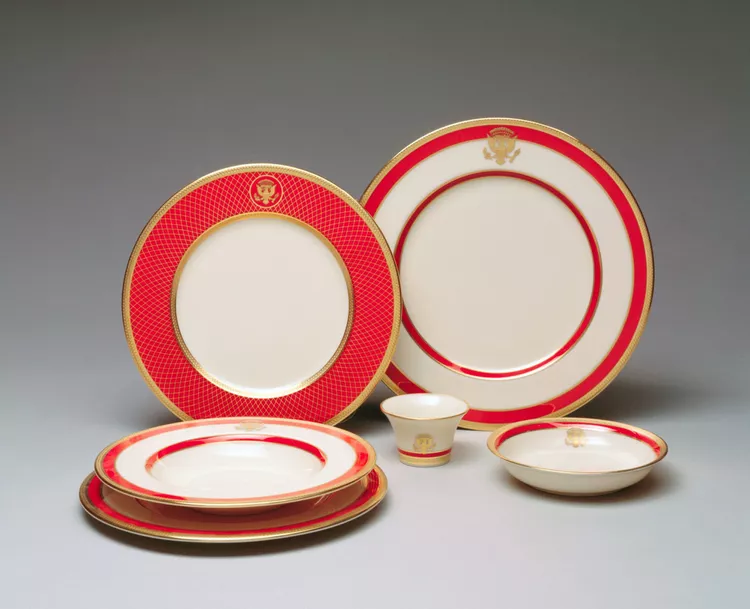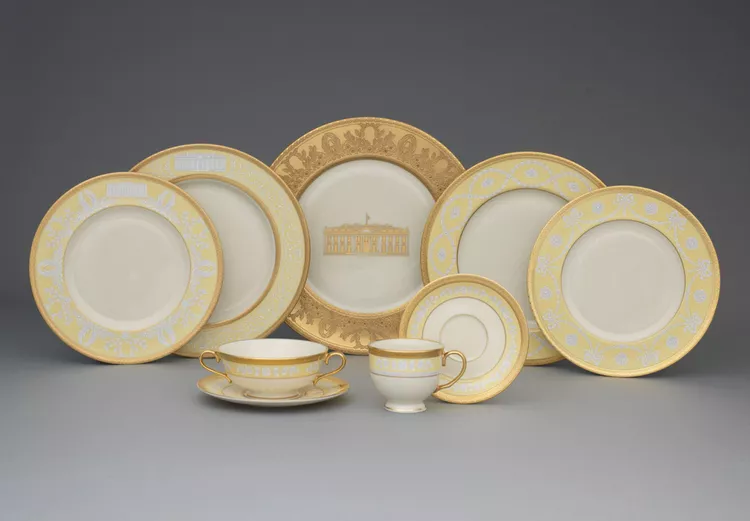If you’re a collector of fine china, chances are you’ve encountered a Lenox item. The iconic porcelain pieces have been highly sought-after for years, but did you know they got their start right here in Trenton?
In addition to its expansive resumé, Trenton is widely recognized as a manufacturing hub of the 19th and 20th centuries. From glassware to steel and everything in between, the City gave meaning to its iconic slogan, “Trenton Makes, the World Takes.” One of the most well-renowned companies to set up shop in Trenton was Lenox, a celebrated manufacturer of American fine china. Walter Scott Lenox, a Trenton native, was born in 1859. Around the time of his birth, the porcelain and pottery industries were booming in the area. Shortly thereafter, Lenox determined that he too would become a ceramicist. Throughout his apprenticeship and training, Lenox would work with the Willetts Manufacturing Company as well as the Ott and Brewer Factory, where Lenox served as the art director.

By the time Lenox turned 30, he had entered into a partnership with Johnathan Coxon Jr. and in 1889 opened the doors of his own business, the Ceramic Art Company. It didn’t take long for Lenox to hit the ground running, and shortly thereafter they were producing a primitive version of their soon-to-be-celebrated wares. Due to limitations in manufacturing capability, Lenox was not initially able to create the sorts of fine glassware that wealthy Americans were after at the time. However, as the business continued to evolve, Lenox trained himself in the techniques required to create fine dishware. In 1894, Lenox bought out Coxon’s share of the business and then became the sole proprietor of his company.
As his business evolved, Lenox’s health unfortunately began to deteriorate. As his condition worsened, he steadily became more reliant on his secretary Harry Brown, who had been with the company since its early days. With Brown’s help, the pair established Lenox Inc. in 1906. Lenox often stated that his goal was to be perceived as a respected fine china manufacturer and be known around the world. He believed he achieved this goal in 1917, when the White House ordered a large table service – this was regarded as the first time that American china was used to entertain heads of state from around the globe. This encounter with the Presidency would not be Lenox’s first, as orders would subsequently be made from Woodrow Wilson, Franklin D. Roosevelt, Harry Truman, Ronald Reagan, and more.

After Lenox’s passing in 1920, his company began garnering even higher esteem. Although the company was still competing with European manufacturers, Lenox was finally able to stand out when it devised its own signature style. Rather than relying on the motifs of European glassware, Lenox embraced a more modern design featuring clean lines and understated artistic additions. Lenox’s wares soon became iconic, and by the end of the 1930s, Lenox had cornered 25% of the domestic market in the United States.
As the company grew, they continued to evolve to meet their customer’s needs. For example, in the 1950s Lenox stepped away from the European model of purchasing an entire service of china. Purchasing a full set was often expensive, making it out of reach for the average family. Rather, Lenox began manufacturing one-, three-, and five-piece sets that were much more attainable for your day-to-day American. Lenox was also the first company to offer a registry for brides-to-be. To this day, Lenox glassware is a celebrated piece of American manufacturing history. Lenox items have been displayed in some of finest museums in the world, including the Metropolitan Museum of Art and the Smithsonian museums. Lenox was even the only American china ever shown at the esteemed Ceramics Museum in France. Lenox items are also enjoyed at the Vice President’s residence, over 300 U.S. embassies, and approximately half of all governor’s mansions.
In countless ways, Trenton has been and continues to remain a center of innovation. Walter Scott Lenox was a visionary, entrepreneur, and artist whose works were celebrated by families and presidents alike. Like so many others, his humble beginnings in Trenton would lead to world-changing feats. To this day, collectors are thrilled to find Lenox’s creations to add to their collection. The next time you sit down for a meal, take a peak at the bottom of your plate – you may just be enjoying the work of one of Trenton’s finest legacies.

SOURCES:
- https://www.company-histories.com/Lenox-Inc-Company-History.html
- https://potteriesoftrentonsociety.org/news-events/blog/lenox-showroom/
- https://www.invaluable.com/blog/inside-the-archives-lenox-china-prices/





